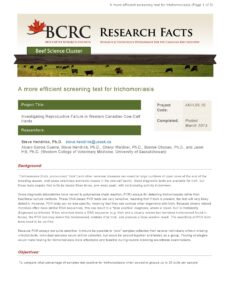A More Efficient Screening Test for Trichomoniasis
Trichomoniasis (or trich, pronounced “trick”) and other venereal diseases can result in large numbers of open cows at the end of the breeding season, and cause enormous economic losses in the cow-calf sector. Good diagnostic tests are available for trich, but these tests require that bulls be tested three times, one week apart, with no breeding activity in between.
A recently-completed research project funded by the National Check-off and Canada’s Beef Science Cluster studied whether samples from multiple bulls could be pooled together and tested as a group using PCR trich tests. If effective, pooling strategies would make testing for trich more affordable and feasible during routine breeding soundness examinations.
The research found that pooled sampling for trich testing is an effective screening tool. The optimal pool size will depend on the expected number of positive bulls; with more positive bulls, smaller pools should be used. Three (3) tested samples per bull is still recommended before considering them negative.
To learn more about this research, view the fact sheet.
Learn more:
Reproduction & Calving webpages on BeefResearch.ca
Click here to subscribe to the BCRC Blog and receive email notifications when new content is posted.
The sharing or reprinting of this BCRC Blog article is welcome and encouraged. Please provide acknowledgement to the Beef Cattle Research Council, list the website address, www.BeefResearch.ca, and let us know you chose to share the article by emailing us at [email protected].
We welcome your questions, comments and suggestions. Contact us directly or generate public discussion by posting your thoughts below.
